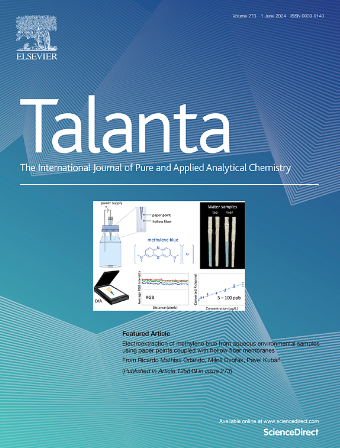基于离子电流整流的裸纳米吸管的粘度响应行为
IF 5.6
1区 化学
Q1 CHEMISTRY, ANALYTICAL
引用次数: 0
摘要
本文采用低粘度电解质溶液灌注裸纳米吸管,实现了对溶液粘度的离子电流整流(ICR)响应能力,为制备纳米吸管粘度探针提供了一种简单的方法。研究了四种不同粘度构型下的ICR现象,并通过双电层和电渗透对纳米吸管尖端电导率的影响来解释纳米吸管的粘度响应机制。通过优化KCl浓度、pH、纳米吸管直径等影响因素,提高了粘度响应灵敏度。数据拟合表明,粘度范围在0.91 mPa以内。s至40.07 mPa。S,纳米吸管的精馏比与溶液粘度呈良好的线性关系(r = 0.04η - 0.02)。此外,裸纳米吸管在粘度响应方面表现出良好的可逆性和选择性,并且也显示出在单细胞细胞质粘度检测中使用的潜力。裸纳米吸管的粘度响应行为为构建细胞质粘度探针提供了重要的见解,这将扩大纳米吸管在细胞质检测中的应用。本文章由计算机程序翻译,如有差异,请以英文原文为准。

The viscosity response behavior of bare nanopipettes based on ionic current rectification
In this paper, bare nanopipettes perfused with low-viscosity electrolyte solutions achieved ionic current rectification (ICR) response capabilities to solution viscosity, providing a simple method for fabricating nanopipette viscosity probes. The ICR phenomenon was investigated in four different viscosity configurations and the viscosity response mechanism of the nanopipette was explained by the effect of the electric double layer and electroosmotic flow on the conductivity of the nanopipettes’ tip. The viscosity response sensitivity was improved by optimizing influencing factors such as KCl concentration, pH, and nanopipette diameter. Data fitting showed that within the viscosity range from 0.91 mPa.s to 40.07 mPa.s, the rectification ratio of the nanopipettes has a good linear relationship with the solution viscosity (r = 0.04η - 0.02). Additionally, the bare nanopipettes exhibit good reversibility and selectivity in viscosity response and also demonstrate the potential for use in single-cell cytoplasmic viscosity detection. The viscosity response behavior of bare nanopipettes provides important insights for constructing cytoplasmic viscosity probes, which will expand the applications of nanopipettes in cytoplasmic detection.
求助全文
通过发布文献求助,成功后即可免费获取论文全文。
去求助
来源期刊

Talanta
化学-分析化学
CiteScore
12.30
自引率
4.90%
发文量
861
审稿时长
29 days
期刊介绍:
Talanta provides a forum for the publication of original research papers, short communications, and critical reviews in all branches of pure and applied analytical chemistry. Papers are evaluated based on established guidelines, including the fundamental nature of the study, scientific novelty, substantial improvement or advantage over existing technology or methods, and demonstrated analytical applicability. Original research papers on fundamental studies, and on novel sensor and instrumentation developments, are encouraged. Novel or improved applications in areas such as clinical and biological chemistry, environmental analysis, geochemistry, materials science and engineering, and analytical platforms for omics development are welcome.
Analytical performance of methods should be determined, including interference and matrix effects, and methods should be validated by comparison with a standard method, or analysis of a certified reference material. Simple spiking recoveries may not be sufficient. The developed method should especially comprise information on selectivity, sensitivity, detection limits, accuracy, and reliability. However, applying official validation or robustness studies to a routine method or technique does not necessarily constitute novelty. Proper statistical treatment of the data should be provided. Relevant literature should be cited, including related publications by the authors, and authors should discuss how their proposed methodology compares with previously reported methods.
 求助内容:
求助内容: 应助结果提醒方式:
应助结果提醒方式:


